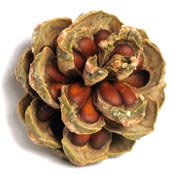Pine nut partnerships
In our efforts to protect America's pine nut resources, we had a good fortune of working with a number of distinguished organizations and individuals. Here we would like to acknowledge three such initiatives.
Institute for Culture and Ecology
Our very good friends and mentors, Institute For Culture and Ecology, wrote up some of our work in their influential publication. IFCAE specializes in the relationship between culture and ecology. Highly endorsed organization and work. Partners also teach at Oregon State University.
National Network of Forest Practitioners
We have worked with NNFP on their non-timber forest products projects. Here is an extract from their February 2008 publication. "Pinyon-juniper ecosystems cover 36 million acres scattered across Colorado, New Mexico, Arizona, Nevada, and Utah. Pinyon trees exist in association with more than 1,000 species of plants, insects, birds, and mammals, and perform important ecosystem services, such as water and soil retention. For ten thousand years, human inhabitants in the Southwest also relied on pinyon trees, primarily for sustenance, shade, firewood, and building materials. To this day, pinyon trees are sacred among the region’s indigenous cultures, and pine nuts – the seeds of pinyon trees – are highly prized among Native American and Hispano residents for their flavor and nutritional value."
PineNut.org
Public Private Partnership works to help protect pinon forest through use of American Pine Nuts
WWW.PinonNuts.org is a website for people interested in managing the Southwest’s pinyon-juniper forests to produce a plentiful and continual supply of pine nuts. This is a call for land managers, scientists, nut harvesters, brokers and others to visit and begin contributing to www.PinonNuts.org.
The site is a modern-day version of a system that the U.S. Forest Service successfully used to support the pine nut industry in the 1930s. It works by having land managers, harvesters, buyers, researchers, and other users post information about pine nut crop conditions, permit requirements, prices, best management practices, etc. in their area to the website’s bulletin board. The website coordinator then transfers this information to the appropriate pages on the website.
Americans use over 10 million pounds of pine nuts every year with a wholesale value of more than $42 million. Until World War II, most of the pine nuts used in the United States came from the Southwest’s pinyon-juniper forests. Today, the majority of pine nuts sold in the U.S. are imported from China. As China’s labor costs increase and global oil prices rise, Southwestern pine nuts will become much more competitive on domestic and global markets over the next few decades.
The site will provide the following and needs your help to keep information up-to-date:
- When and where to find abundant pine nut crops
- Where to get harvesting permits and leases
- How to harvest pinyon nuts without damaging trees
- What techniques people are using to manage pinyon and other pines for nut production
- Contact information for pinyon nut harvesters, brokers, and land managers
If you have information to share about these topics, please post the information on the www.PinonNuts.org bulletin board or send an email to Penny Frazier at pinenuts@pinenut.com.
www.Pinonnuts.org is the product of a public-private partnership between the Bureau of Land Management, Colorado Wood Utilization and Marketing Program (www.colostate.edu/programs/cowood), the Institute for Culture and Ecology (www.ifcae.org), and Goods from the Woods (www.pinenut.com).




